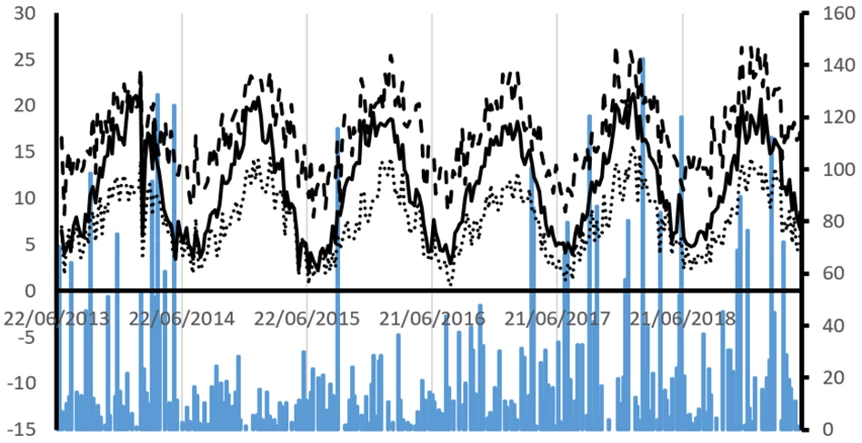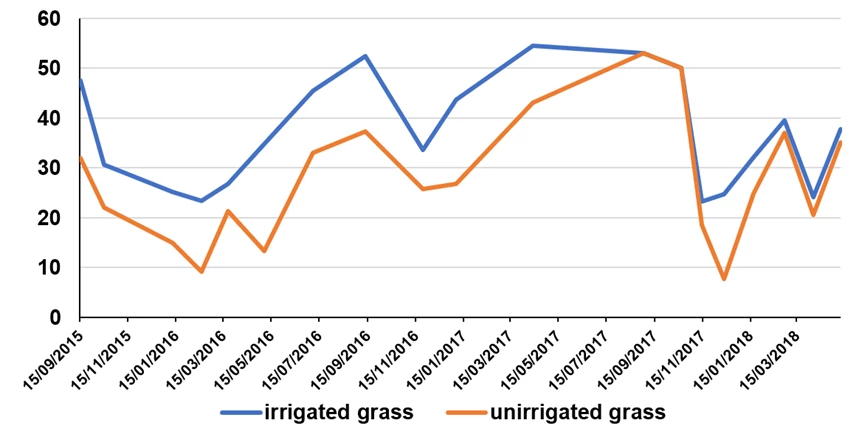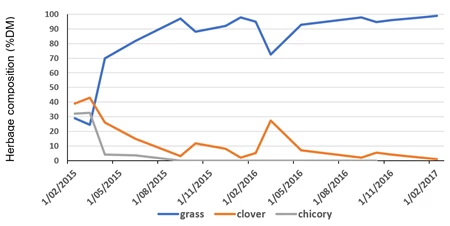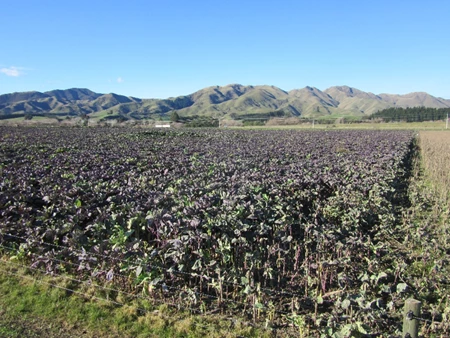Forages for Reduced Nitrate Leaching, Blair and Amie Kirkland (Canterbury)
11 min read
11 min read
Blair and Amie Kirkland own a sheep and beef farm in Parnassus and played a key role in FRNL research alongside other Canterbury farmers. Their farm spans 440 ha, where they grow crops like kale, fodder beet, turnips, and maize to feed their animals, including Longdown ewes and South Devon x Angus cattle. Through the FRNL programme, they gained insights into pasture growth, saw various production systems, and provided practical views on research. They joined the programme to understand the environmental impact of their dairy grazing and to find solutions. They believe the programme offers scalable improvements for the wider farming community.
Blair and Amie Kirkland are sheep and beef farm owners from Parnassus. They were part of a network of farmers in Canterbury who contributed to the direction of the FRNL research, influenced priorities, shared experiences and provided a practical check to research.
Area:
430 ha effective, 440 ha total
Dominant soils:
Wakanui silty loam
Dominant soils (over clay):
Claremont silty loam, and Cairnlea silty loam
Average rainfall:
approx. 800 mm
Under pivot irrigation:
163 ha
Crops (winter feed):
grown include kale and fodder beet
Crops (autumn feed):
Catch crops, Pasja, leafy turnips, rape, giant rape and maize
Animals:
2000 breeding Longdown ewes
Animals (before 2017):
23 breeding South Devon x Angus cattle
Animals (additional):
beef calves, R1 dairy heifer and winter dairy cow grazers
“As we have winter dairy grazing by the river, we want to know the environmental impact of that and also want to be involved in finding solutions.”
"As time goes on, focus is shifting more on the environmental sustainability of our business. This has significant implications for society’s perception of the industry and our marketing."
“The programme discovered what improvements can be made at the small scale first. Now this can be filtered out to the wider community.”
Irrigation
Irrigation has a marked effect on the management on farm and ability to cope during droughts. This has a notable effect on stocking rates and nitrogen (N) leaching.
Estimated N leaching increased over the monitoring period (see table below). This was due to an increase in winter grazing and a steady increase in the total amount of dry matter produced and consumed on the farm (2.8 million kg to 3.6 million kg). The area under irrigation also increased producing more herbage with an accompanying increase in stock density from 13 to 19 SU/ha. An increasing proportion of the dry matter was also consumed by dairy cows.
Winter fodder crops were identified as a large source of N leached from the farm and produced 15-20% of the dry matter intake. These are grown on a small proportion (<10%, or 44 ha) of the farm and the timing and intensity of grazing contribute to the higher N leaching losses. Catch crops were found to be the most appropriate solution to the problem.
| Farm details | 2014/15 | 2015/16 | 2016/17 | 2017/18 | 2018/19 |
| Beef (kg)1 | 64,080 | 61,612 | 37,987 | 57,857 | 63,185 |
| Sheep meat (kg) | 58,831 | 61,526 | 65,114 | 64,242 | 66,386 |
| Wool (kg) | 15,458 | 15,000 | 15,186 | 15,377 | 15,715 |
| Total animal production (kg) | 138,369 | 138,138 | 118,287 | 137,475 | 145,286 |
| Pasture production (kg DM/ha)2 | 7,282 | 7,646 | 9,933 | 12,438 | 11,503 |
| Total Dry Matter Intake (DMI; kg) | 2,820,611 | 3,187,959 | 3,312,786 | 3,131,522 | 3,640,429 |
| Dry matter intake (OVERSEER; kg/ha) - total | 6,567 | 7,414 | 7,704 | 7,283 | 8,466 |
| Stocking rate (SU/ha) | 13.5 | 13.6 | 14.5 | 16.2 | 19.1 |
| N leaching losses (kg N/ha) | 20 | 23 | 25 | 38 | 45 |
| N leaching (kg N/kg product) | 0.079 | 0.073 | 0.094 | 0.122 | 0.139 |
1 "Beef" means both beef carcass and that leaving the farm as live weight gain on grazed dairy cattle.
2 Weighted average from Farmax (potential + fertiliser N boosted)
Weather information

Weekly rainfall (blue bars), air temperature (max dashed line, min dotted line) and soil temperature (solid line) from July 2013 to June 2019 based on interpolated weather data from NIWA’s Virtual Climate Station Network (https://www.niwa.co.nz/climate/our-services/virtual-climate-stations)

Average soil moisture assessments from two pastures.
Plantain and chicory in diverse mixtures
Plantain and chicory were incorporated into diverse mixtures on the farm following discoveries around their potential to help reduce N leaching. Mixed pastures produced more than those predominantly in grass whether irrigated or not.
Total dry matter production (kg/ha) assessed using pasture cages from 6 Sept 2017 to 6 Sept 2018 (2017-18), and 6 Sept 2018 to 28 May 2019 (2018-19).
| Name | Water | Slope | Species | DM kg/ha | |
| 2017-18 | 2018-19 | ||||
| Wacca | irrigated | Flat | Grass | 15,082 | 12,042 |
| Mushroom 2 | irrigated | Flat | White clover & chicory | 20,900 | 13,456 |
| Stable 2* | irrigated | Flat | Grass-white clover-plantain | 16,387 | 16,641 |
| Stable 2* | irrigated | Slope | Grass-white clover-plantain | 15,658 | 15,777 |
| Boomerang | unirrigated | Flat | Grass | 7,596 | 9,722 |
| Rutherford | unirrigated | Flat | Grass-white clover-plantain | 8,760 | 11,433 |
*Stable 2 has flat and sloping terrain in one paddock which was sown with the same mixture.
As shown in the figure below clover and chicory vanished from this pasture within two years of sowing. It is possible that sheep or cattle grazing these pastures targeted the plantain or chicory and grazed them out, or the presence of N gave the grass a competitive advantage.

The species composition of a pasture sown with grass, clover and chicory.
Plantain was present particularly in the unirrigated pasture. It was also noted that in one paddock ("Stable 2") that there was more plantain on sloping ground (10%) than on the flatter area of the irrigated paddock (<1%). This led to the cautious suggestion that plantain will be more competitive on drier sites compared with the other species sown here. Grass had become the dominant species in all swards by the following year, with the exception of the paddock sown only with clover and chicory. Loss of clover and herbs from these pastures would reduce herbage quality.
When examined more closely, the proportion of plantain on different topography, and different irrigation conditions showed that for the irrigated slope plantain became a modest proportion of the herbage in late summer and early autumn. In February this area had 30% plantain which is the level at which it has been found to mitigate N leaching. However, the flat areas had very little. The unirrigated area sown in 2016 had more than 30% plantain for much of the period measured and could be expected to reduce N leaching. In this paddock, the plantain had re-established itself from seed following summer drought, whereas other species had not.
The proportion of plantain recorded in samples from three pastures.
The figure below shows that there was little growth of any of the pastures between May and September.
Fodder crops
Fodder beet and kale fodder crops are grown in rotation as winter feed for adult dairy cows each year. Crop yields were monitored for the five years between winter 2015 and 2019 as shown in the tables below. Fodder beet gave consistently high yields (17.5 to 33.3 t DM/ha) under irrigation, whereas kale had lower yields (4.3 to 16.1 t DM/ha). N leaching losses were estimated with Overseer for fodder crops in the 2017-18 and 2018-19 seasons.

Kale fodder crop
| Paddock | Date | DM (kg/ha) | Area of paddock (ha) | N leaching losses (kg N/ha) |
| Collard Pie | 10/6/15 | 29,521 | 4.08 | |
| Railway pivot | 13/5/16 | 24,589 | 16.83 | |
| Mushroom 1 Mushroom 2 | 13/5/16 13/5/16 | 26,491 29,608 | 4.77 4.59 | |
| Leader pivot | 2/5/17 | 24,139 | 9.61 | |
| River pivot | 2/5/17 | 25,156 | 9.61 | |
| Bridge | 7/6/18 | 17,570 | 7.41 | 252 |
| Collard | 7/6/18 | 33,392 | 4.99 | 59 |
| Half-moon & Highway | 17/6/19 | 29,977 | 4.47 | 37-58 |
| Sisters | 17/6/19 | 18,357 | 4.63 | 14 |
| Paddock | Date | DM (kg/ha) | Area of paddock (ha) | N leaching losses (kg N/ha) |
| Derry Hill | 22/4/15 | 4,286 | 5.10 | |
| Derry Hill | 1/4/16 | 10,077 | 5.10 | |
| Leader pivot (irrigated) Leader (unirrigated) | 10/8/16 10/8/16 | 6,090 4,332 | 7.40 (7.40) | |
| Killer shed | 2/5/17 | 11,587 | 5.24 | |
| Sisters | 2/6/17 | 6,748 | 4.15 | |
| Railway pivot | 7/6/18 | 16,117 | 16.83 | 49 (irr) 8 (dry) |
| River pivot | 7/6/18 | 10,861 | 9.61 | 190 (irr) 109 (dry) |
| Railway pivot Bridge River pivot | 17/6/19 17/6/19 17/6/19 | 8,862 7,885 8,485 | 16.83 7.41 9.61 | 108 (irr) 53 (dry) 240 170 |
Fodder crops such as Pasja, leafy turnip, rape, giant rape and maize are sown for autumn feed. Some crops are allowed to recover after the initial grazing and are grazed again. This means that N at risk of leaching may be caught by a subsequent crop or pasture following autumn grazing. However, for those grazed in June a catch crop would be required to reduce the risk of high N losses.
| Paddock | Species | Date | DM (kg/ha) | Area of paddock (ha) | N leaching (kg N/ha) |
| Mushroom 1 Leader Half pipe Mushroom 2 | Pasja Pasja Pasja Pasja | 7/1/15 18/2/15 24/3/15 24/3/15 | 6,309 6,453 10,140 6,106 | 4.77 7.84 4.75 4.59 | |
| Kerry’s corner | Leafy turnip | 12/2/16 | 3,318 | 1.42 | |
| Hayshed Ram | Leafy turnip Leafy turnip | 12/2/16 12/2/16 | 1,547 1,435 | 6.53 6.01 | |
| Derry Hill Killer shed | Giant rape Giant rape | 21/3/16 1/4/16 | 2,083 3,933 | 8.08 5.24 | |
| Leader pivot | Maize | 21/3/16 | 9,093 | 7.4 | |
| Ram Top Gully Jundee | Rape Rape Rape | 2/5/17 15/3/17 5/4/17 | 3,121 3,200 3,800 | 6.01 5.16 3.45 | |
| Nimary | Rape | 5/4/17 | 3,800 | 3.69 | |
| Road | Giant rape | 5/4/18 | 8,395 | 3.32 | |
| Road | Giant rape | 28/6/18 | 14,720 | 3.32 | 40 |
| Collard Road Strip | Giant rape Giant rape Giant rape | 17/6/19 17/6/19 17/6/19 | 6,192 6,679 5,998 | 4.99 7.5 4.65 | 377 201 160 |
Catch crops
Catch crops planted in 2017 after fodder beet grazing were not particularly successful due to extremely wet conditions, as shown in the table below. Oats and triticale were sown on 5th July 2017 (9 days after grazing), and 31st August 2017 (16 days after grazing). Very few cereal plants survived the July sowing. Despite a poor survival of plants in the August sowing, more than 2 t DM/ha was grown in just 71 days.
Performance of catch crops sown immediately post-winter grazing of fodder beet, assessed on 10 Nov 2017
| Cereal | Plant counts | Survival* | Composition (%) | Herbage mass (kg DM/ha) | |||
| (n/m2) | (%) | cereal | other | cereal | other | ||
| Sown 5 July 2017 | |||||||
| Control | 0 | ||||||
| Oats | 5 | 1.0 | |||||
| Triticale | 1 | 0.2 | |||||
| Sown 31 August 2017 | |||||||
| Control | 0 | 0 | 0 | 0 | 0 | ||
| Oats | 147 | 25.2 | 100 | 0 | 2,865 | 0 | |
| Triticale | 78 | 19.9 | 100 | 0 | 2,215 | 0 |
Further catch crop trials were sown in 2018 after kale grazing. Barley was direct drilled on 27 July 2018 (cultivar “Monty”). Control plots were kept fallow. At the start of November, plots were split in half and SustaiN fertiliser (60 kg N/ha) was applied to one half of each plot. Seedling counts showed reasonable establishment. An average of 5.5 t DM/ha had accumulated by the 26 November 2018 (6.2 t DM/ha for those that received N).
Seedling establishment on 26 Sept 2018 and dry matter production (kg/ha) from catch crop and fallow plots on 26 Oct 2018 and 26 Nov 2018 (with and without added N fertiliser on 1 Nov).
| Plot | Treatment | Seedling count/m² | DM (kg/ha) 26/10/18 | DM (kg/ha) 26/11/18 | |
| + N | No N | ||||
| 1 | Fallow | - | - | - | |
| 2 | Barley | 152 | 1,391 | 5,383 | 6,284 |
| 3 | Barley | 102 | 1,441 | 5,627 | 5,403 |
| 4 | Fallow | - | - | - | |
| 5 | Fallow | - | - | - | |
| 6 | Barley | 123 | 1,456 | 7,669 | 4,899 |
Measurements of soil mineral N were collected at three depths (0-15 cm, 15-30 cm, and 30-60 cm) on 6 Dec 2018.
Concluding comments Blair
“Winter grazing of crops with cattle is our biggest risk of losing N to water. The Trials have shown early sowing of catch crops to take this N back up from the soil to be very beneficial. The practicality of doing this will vary each year, with soil condition, rainfall and stage of rotation of the paddock all needed to be taken into consideration. As farmers we still need sowing a catch crop to be a profitable exercise, and obviously want to minimise the risk of crop failure associated with sowing too early into damp, cold soils.”
“Plantain has shown benefits of lower N being excreted, but has severe limitations in being able to maintain a sward composition of 30%. We have definitely noticed this on our property, and feel that not being a great competitor with companion species will limit its N reduction use going forward.”
Download the full report on the Sheep and Beef monitor farms, including the catch crop results, here: